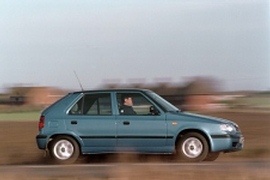SKODA Felicia Models/Series Timeline, Specifications & Photos
First production year: 1995
Engines: Gasoline, Diesel
Skoda introduced the Felicia lineup in 1995 after a massive improvement over its predecessor, the wedged-styled Favorit.
When Volkswagen acquired the Skoda Auto in 1991 after the fall of the Czechoslovakian communist regime, it found a factory with skilled workers but less know-how and technologies than the Western European carmakers. After a transition period, the Czech brand reshaped its already developed Favorit lineup, and thanks to a new assembly line, it launched the Felicia in 1995.
Volkswagen helped the carmaker in developing the small-segment hatchback. The platform was good, and the overall shape was not bad either. At the front, it featured rectangular headlights with clear, corner-mounted turn signals. In the middle, the carmaker placed a redesigned grille with vertical slats and a chromed surrounding. The greenhouse was about the same size as an MK2 VW Polo, but it provided a raked-forward C-pillar.
Skoda built the Felicia as an econobox, and the interior showed that. It was well designed, with a round-shaped dashboard and an instrument cluster extended over the center stack. The base trim level featured cranked windows and no power steering. Its front seats offered a decent amount of space, but the rear bench was cramped even for two average-sized adults. Its trunk provided just a mere 272 liters (9.6 cu-ft) of space with the rear seats up and up to 976 liters (34.5 cu-ft) with the seatback folded.
When Skoda introduced the Felicia on the market, it offered only one engine option: a 1.3-liter, fuel-injected engine. From 1995 the car received two additional powerplants: 1.6-liter gasoline and a 1.9-liter naturally aspirated diesel unit, produced by Volkswagen.
